In this post I have explained how a shunt regulator IC works typically in SMPS circuits. We take the example of the popular TL431 device and try to understand its use in electronic circuits through a few of its application notes.
Electrical Specifications
Technically the device TL431 is called a programmable shunt regulator, in simple terms it may be understood as an adjustable zener diode.
I have explained more about its specifications and application notes.
The TL431 is attributed with the following main features:
- Output voltage settable or programmable from 2.5V (minimum reference) up to 36 volts.
- Output Impedance low dynamic, around 0.2 Ohm.
- Sink current handling capacity up to maximum 100mA
- Unlike normal zeners, noise generation is negligible.
- Switching response lightning fast.
How the IC TL431 works?
The TL431 is a three pin transistor like (such as BC547) adjustable or programmable voltage regulator.
The output voltage can be dimensioned using just two resistors across the specified pin outs of the device.
The diagram below shows the internal block diagram of the device and also the pin out designations.
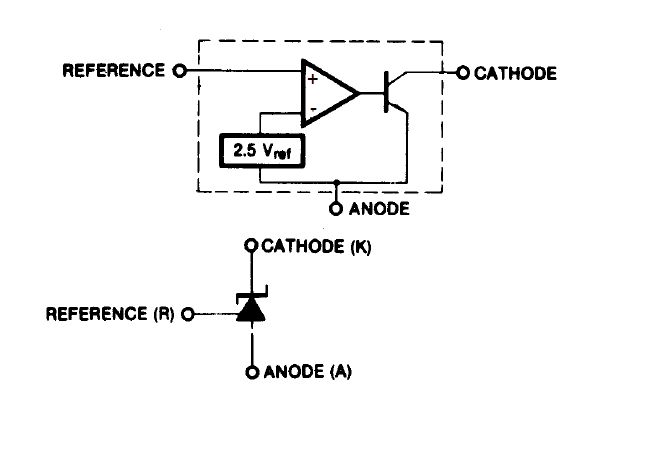
The following diagram indicates the pin outs of the actual device. Let's see how this device can be configured into practical circuits.
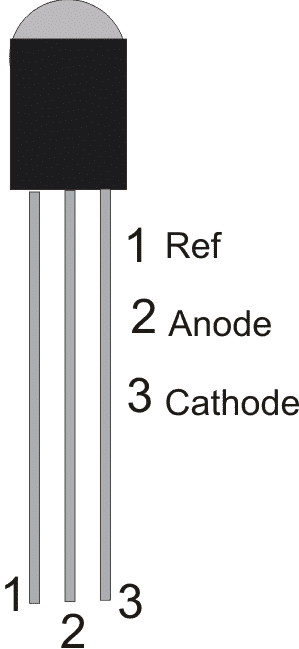
Circuit Examples using TL431
The circuit below shows how the above device TL431 can be used as a typical shunt regulator.
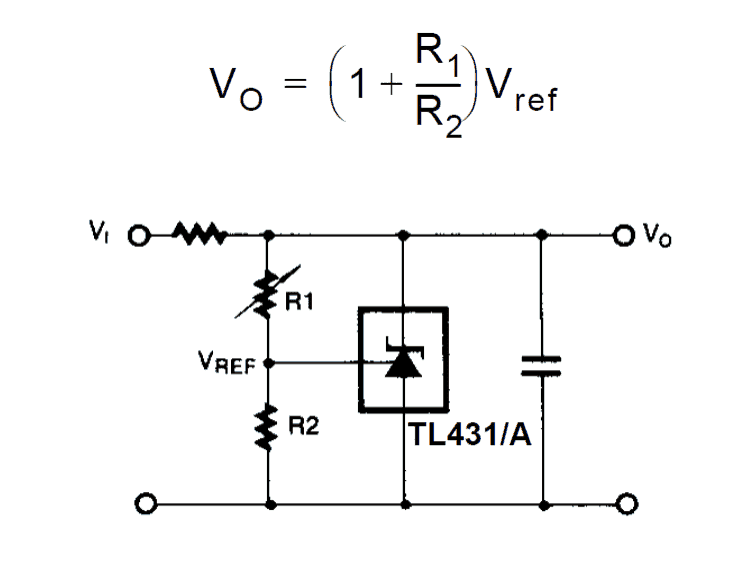
The above figure shows how with the help of just a couple of resistors the TL431 can be wired up as a shunt regulator for generating outputs between 2.5v to 36v. R1 is a variable resistor which is used for adjusting the output voltage.
The series resistor at the supply positive input can be calculated using Ohm's law:
R = Vi / I = Vi / 0.1
Here Vi is the supply input which must be below 35 V. The 0.1 or 100 mA is the maximum shunting current specification of the IC, and R is the resistor in Ohms.
Calculating Shunt Regulator Resistors
The following formula holds good for acquiring the values of the various components used for fixing the shunt voltage.
Vo = (1 + R1/R2)Vref
Here Vref is always equal to 2.5 V, which is internally set for the TL431 IC.
So the formula finally can be expressed as:
Vo = (1 + R1/R2) x 2.5
Practical Example
Let's try to understand the calculations through a practical example, as shown below:
In this example we will try to use the TL431 to regulate the output supply voltage to 12 V.
Let's assume we have all the parameters given, except R1.
- Given:
- Vo = 12V
- R2 = 1K
- R1 = ?
- Vref = 2.5
Vo = (1 + R1/R2) x 2.5
12 = (1 + R1/1000) x 2.5
12 = [(R1 + 1000) / 1000] x 2.5
12/2.5 = (R1 + 1000) / 1000
4.8 = (R1 + 1000) / 1000
4800 = R1 + 1000
R1 = 3800 = 3.8 K
Thus, by using a 3.8 K resistor for R1 we can regulate the output voltage of the TL431 to an exact 12 V level. Likewise, you can alter the values of R1 and R2 to get other regulated values at the output as required.
Modifying 78XX IC Output Voltage using TL431
In case a 78XX needs to be used in conjunction with the device, the following circuit can be used. In this example we can see how the output voltage of the a 7805 IC is modified to increase above its normal 5 V level. For example here the 7805 IC output could be increased to 9V by suitably adjusting the TL431 parameters.
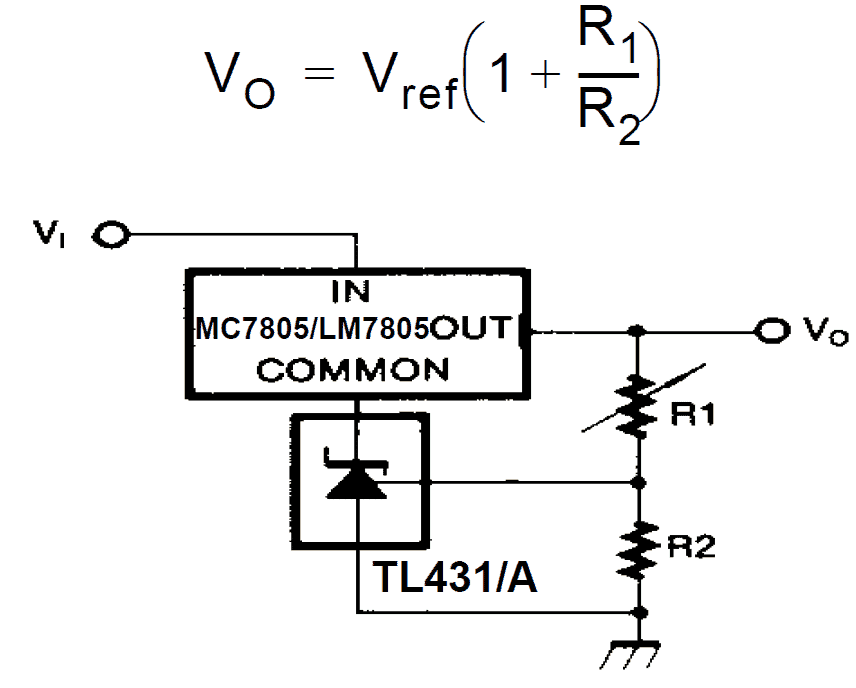
The ground of the TL431 cathode is connected with the ground pin of the 78XX. The output from the 78XX IC is connected with the potential divider network which determines the output voltage.
The parts can be identified through the formula shown in the diagram.
The above configurations are restricted to a max 100 mA current at the output.
Making a High Current Shunt Regulator using TL431
Normally, the TL431 adjustable zener diode cannot used with currents over 100 mA. However this device can be configured to shunt higher amount of currents by adding an external shunting transistor with the output of the TL431.
For working with higher current a transistor buffer may be used, as shown in the following circuit.
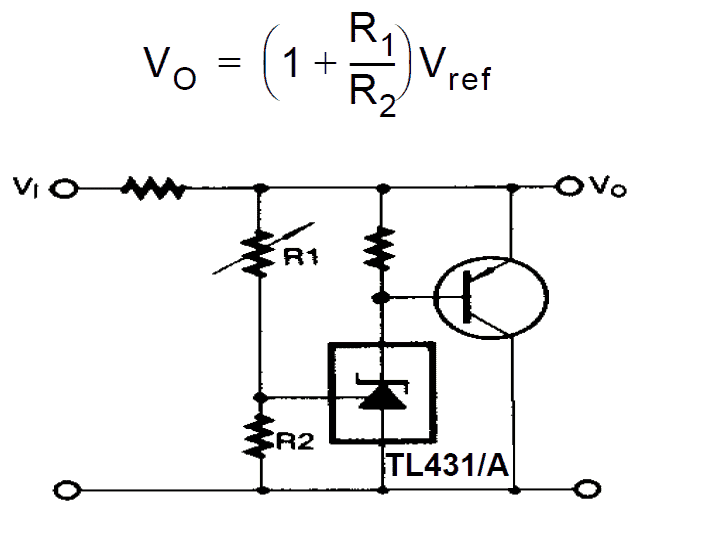
In the above diagram most of the parts placement is similar to the first shunt regulator design, except that here the cathode is provided with a resistor to positive and the point also becomes the base trigger of the connected buffer transistor.
The output current will depend on the magnitude of current the transistor is able to sink.
In the above diagram we can see two resistors whose values are not mentioned, one in series with the input supply line, another at the base of the PNP transistor.
The resistor at the input side limits the maximum tolerable current that can be sinked or shunted by the PNP transistor. This can be calculated in the same way as discussed previously for the first TL431 regulator diagram. This resistor protects the transistor from burning due to short circuit at the output.
The resistor at the base of the transistor is not critical and may arbitrarily selected anything between 1k and 4k7.
Making a Precision Shunt Regulator using TL431 for Windmill Applications
The following image shows how the TL431 device can be used for controlling windmill generators for charging upto 48 V batteries.
In this design, the TL431 IC is well protected with 12 V zener diodes to ensure the internal circuitry of the device is not subjected to extreme breakdown voltages.
The 1K preset is adjusted such that the TL431 just conducts at around 56 V which is optimal level for charging a 48 V battery.
As soon as the TL431 conducts, the T1 shuts off, causing T2 to turn ON.
When T2 turns ON, it shunts the supply voltage to ground thus regulating the supply voltage at the desired level.
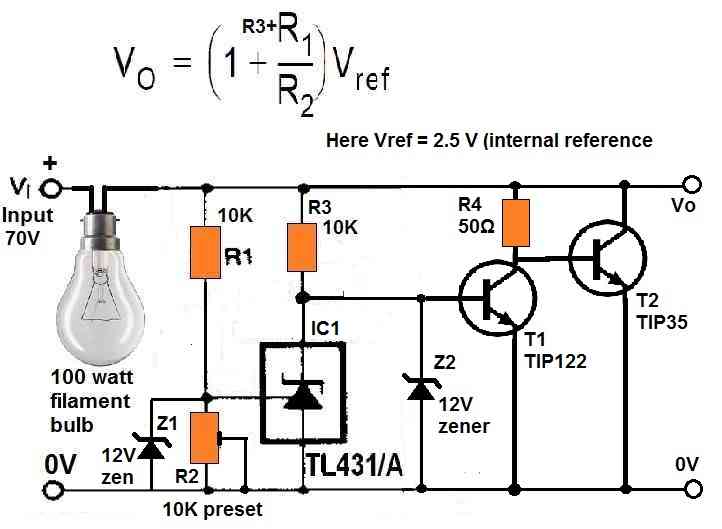
Application Areas of the IC TL431
Although the above configurations can be used in any place where precision voltage setting and references may be required, it's extensively used in SMPS circuits nowadays for generating precise reference voltage for the connected opto coupler, which in turn prompts the input mosfet of the SMPS to regulate the output voltage precisely to the desired levels.
For more info please go to TL431 Datasheet
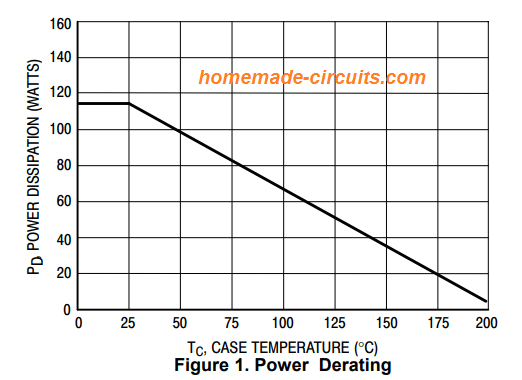



Hi Swagatam
Do you agree that in “High Current Shunt Regulator using TL431” circuit, when the real output voltage drops below the calculated voltage (meaning current shortage) then there should be almost no current left for the transistor to pass (because there is no excess current) and it should not get hot?
Hi SAsa,
The best way to check is to add an LED in series with the transistor base, and then calculate the R1/R2 by taking into account the LED fwd drop. Then if you see the LED is not illuminating, that means the transistor is not conducting due to output overload condition.
Checking is for later.
First, do you agree with what I said (that when the real output voltage drops below the calculated voltage, then there should be almost no current left for the transistor to pass)?
Yes that’s correct, only if you are 100% sure the BJT is not getting any base current, or your circuit does not have any other flaws.
1.For checking if the transistor is conducting while there is output voltage drop, I had connected an ammeter between the collector and the GND. About 0.28 Amps was flowing there, whereas the output voltage was 5.44 instead of 6.75.
Is it necessary to use also your method of checking (“add an LED in series with the transistor base, and then calculate the R1/R2 by taking into account the LED fwd drop”)?
2.I will upload the schematic of my circuit as soon as possible..
Using an Ammeter is fine. If you want to use an ammeter, then please connect the ammeter in series with the collector of the transistor, that will give you a clear idea regarding whether the transistor is conducting or not…
Is it possible to change the zener diode that regulates voltage on a 5V 2A old mobile adapter with a variable regulator built above with the TL431
Yes, that’s possible.
Dear Swagatam
Hello again
I provided the needed components for “High Current Shunt Regulator using TL431”. Input resistor: 9.5 Ω; R1: 43.66 KΩ; R2: 25.77 KΩ; Cathode/Base resistor: 1.5 KΩ; PNP: TIP42C. (I can email the schematic of my circuit, if you need.)
When no load is connected, the output voltage is 6.81-6.83 (almost OK). But when I connect a 11.7 Ω 15W resistor as load, the output voltage drops to about 4.8 volts across the positive and the negative ends of the 3 parallel lines of the circuit, and to about 4.3 volts across the load (11.7 Ω 15W resistor).
1. Why my circuit is unable to regulate the out output voltage while the load is connected?
2. How can this problem be solved?
Hi SA,
It is because of lack of current, the output is not able to maintain the specified output voltage level.
Please try reducing the 9 ohm resistor value and check the response.
1. You said “It is because of lack of current”. But input voltage is 16 volts; 16V/9.5Ω=1.6A. Is not 1.6A more than enough?
2. I reduced input resistor to 3Ω; the output voltage across the load is now 4.8 volts (instead of 4.3 volts), still much below the 6.81-6.83 that it should be.
I think the problem might be happening due to shunting effect by the transistor, which could be interfering with the current output.
Can you please tell me why you chose the TL431 shunting method, instead of other direct regulator methods, using transistor emitter follower?
1. I used “TL431” to get accurate output voltage; I used its “High Current Shunt Regulator” circuit to get more current than simple TL431 circuit.
2. What are “other direct regulator methods, using transistor emitter follower”?
Below shown example is a simple emitter follower regulator which will give you an output voltage as desired by you with ample current. The output will be around 1V lower than the zener diode value. Please connect a 4.7k resistor between the BJT emitter and ground of the circuit for an improved output regulation:
https://www.homemade-circuits.com/wp-content/uploads/2021/11/single-transistor-voltage-regulator.jpg
I had tried this “emitter follower regulator” before trying “High Current Shunt Regulator”. But the output was not constant: it changed with different load currents.
More importantly:
Inspired by what you said (“It is because of lack of current”), I tried to examine the fundamental current capacity of the circuit. So, I disconnected “High Current Shunt Regulator” from the supply and connected the load directly to the supply: 16 volts dropped to 4.5 volts!!! So it seems that the culprit is the supply, not “High Current Shunt Regulator”. Thank you very much indeed for your insight and inspiration.
Sounds perfect! Yes, if the source supply lacks current then nothing prevent the output voltage drop. Thanks for updating the results.
Hello again, Swagatam
Given what I said in my last comment about the weakness of the supply, I changed the supply. The weak supply was a 16-volt transformer. The present supply is “+12 output of a 400-watt ATX power supply”.
Then, I used a “11.7 Ω 15W resistor” as load.
EVEN WITH THIS POWERFUL SUPPLY, the output voltage of my High Current TL431 Shunt Regulator dropped from 6.83 volts (without load) to 5.7-5.9 volts (with load).
Hello SA, can you please check the output voltage without the TL431 circuit, rather directly using resistor divider, that will verify your power supply specifications.
Please explain what you mean more.
Do you mean that I reduce 12 volts to 6.8 volts by resistor divider, and then connect the “11.7 Ω 15W resistor” as load to 6.8 output?
Or
Do you mean that I connect “11.7 Ω 15W resistor” as load directly between +12 and GND of the ATX power supply?
Yes, I mean to say connect the load directly across the ATX 12V output. If your ATX has sufficient current delivering capacity above 1.5 amps then the 12V will not drop, or it may drop a couple of volts only.
If you check the values in the following Ohm’s law calculator you will find that the minimum current required for the 11.6 Ohms load is around 1 amp, so if this much current is fulfilled through the load then the voltage across it must not drop. Please let me know how it goes:
https://www.homemade-circuits.com/ohms-law-calculator-software/
On June 7, 2025 at 8:00 am, you said “Yes, I mean to say connect the load directly across the ATX 12V output….”.
I had done this before, of course. +12 volts only dropped to 11.8 volts by connecting 11.7 ohm resistor.
Good, so that proves the problem is in the TL431 setting, or the shunting transistor integration. In that caase you have two options, try using a PNP BJT setup, as discussed in the above article, or simply go for the following emitter follower design, which is a fool proof design and I recommend this design:
https://www.homemade-circuits.com/wp-content/uploads/2021/11/single-transistor-voltage-regulator.jpg
As I said in a previous comment, I want to use “High Current Shunt Regulator using TL431” to regulate a 16-volt (it is 16 volts when disconnected from the battery) rectified DC voltage from a transformer and make a constant voltage to charge a 6-volt sealed lead acid battery.
The voltage that would be the input voltage for the high current shunt regulator is different according to whether the load (6-volt 5AH SLA battery) is connected or not: while connected, it changes according to load resistance (e.g., when the battery is almost full, it is about 10.5 volts), while disconnected, it is about “16 volts”.
Which voltage, with load or without load, must be regarded as “the input voltage” in the calculations of current, resistance, wattage of components, etc. of the high current shunt regulator? For example, when calculating the wattage of the transistor, should 16 volts be multiplied by the current?
OK got it, in that case you must consider the highest possible input voltage and current, which is 16V here, for calculating the maximum tolerance of the transistor.
Hi dear Swagatam
In “High Current Shunt Regulator using TL431”, is there a way to use NPN transistor instead of PNP transistor? If no, can you please explain why?
Hi SA, I think the following configuration should work, if you want to use an NPN transistor:
https://www.homemade-circuits.com/wp-content/uploads/2025/05/shunt-regulator-using-TL431-and-NPN-BJT.jpg
Hello Swagatam
On March 6, 2020 at 9:55 am, you replied to some one: “…a shunt regulator is not recommended for a transformer based supply…”. On April 17, 2020 at 1:52 pm, in another reply you said “For trafo based charger it is better to go for normal linear voltage regulators like LM338 etc…”.
Is it a bad idea too to use “High Current Shunt Regulator using TL431” to regulate a 16-volt (it is 16 volts when disconnected from the battery) rectified DC voltage from a transformer and make a constant voltage to charge a 6-volt sealed lead acid battery? If it is a bad idea, please explain why.
Hello SA, It can be a bad idea if the source is a high current source, because then the source will start dissipating a lot of heat, wasting lots of power. For low current sources, it is OK to use a shunt regulator. However for a source like solar panel, it may alright to use a shunt regulator even if it is a high current solar panel…
Hello again Swagatam
At the end of the Section “Making a High Current Shunt Regulator using TL431”, you said “The resistor at the base of the transistor is not critical and may arbitrarily selected anything between 1k and 4k7.”
Does not the value of this resistor and therefore the amount of current that flows to the Base of the transistor have any impact on the bahaviour of the transistor? If no, why? If yes, what is that impact?
Hello SA, yes that’s correct, because the base/emitter resistor for the PNP is not responsible for the conduction of the transistor, it is included just to make sure the base of the BJT does not float at an undefined potential at any point of the circuit operation.
The PNP conduction is handled solely by the TL431 device…
Thank you dear Swagatam for your post
I have questions about “Making a High Current Shunt Regulator using TL431” section:
1. How can I know “the magnitude of current the transistor is able to sink”, for example a TIP42C?
2. How can I know “the maximum tolerable current that can be sinked or shunted” by for example a TIP42C transistor?
3. You said “This can be calculated in the same way as discussed previously for the first TL431 regulator diagram”. Please explain how this can be calculated (for example) for a TIP42C.
Thanks in advance
Hi SA, thank for this interesting question.
For knowing how much current or power a transistor can handle, for example TIP42, you must look for something like this parameter in its datasheet:
https://www.homemade-circuits.com/wp-content/uploads/2025/04/bjt-power-dissipation.jpg
Here you can see the figure 65 watts which is the maximum tolerable watts the transistor can handle as long as its TC = 25 degrees Celsius, meaning as long as its case temperature does not exceed 25 degrees C.
Theoretically TIP42 should be able to handle power that’s equal to collector/emitter voltage rating multiplied by collector current, 100 * 6 = 600 watts, but again this may be possible if you are ale to maintain its case temperature below 25 degrees Celsius, using massive heatsink and maybe water cooling etc, which may sound impractical.
Thank you for you answer Swagatam
You said “65 watts which is the maximum tolerable watts the transistor can handle as long as its TC = 25 degrees Celsius”. Then you said “Theoretically TIP42 should be able to handle power that’s equal to collector/emitter voltage rating multiplied by collector current, 100 * 6 = 600 watts”.
Given that TIP42 can tolerate only up to “65” watts (for example, 10.83 V*6 A= 65 watts), how can it handle “600” watts (for example, 100 V*6 A= 600 watts)?
Thank you SA,
Yes theoretically it can take 600 watts if you are able to keep its case temperature below 25 degrees Celsius, which is a big challenge, and almost impossible.
Hi Mr Swagatam;
On my charger circuit, the output voltaga as the 88,5V goes thru the 5K resistor to the cathode of the TL431. The measurement value as the follovings:
The voltage over the 5K resistor is about 85V. Cathode output voltage is about 5,5V and Reference voltage is about ,4V. Meanwhile I removed the above mentioned 5K with the 4K7 5W resistor since the former was defective and also removed the led driver IC (I think it is PIC16XXXX type) which is driven by the TL43 since it was defective too. At the moment I have the output voltage but still this 5K (or 4K7) is overheating. So I need your opinion please if possible?
Hi Suat,
The 4k7 is heating up because it has to dissipate overcurrent due to the excess voltage of 85 – 5.5 = 79.5V.
The only way to stop this is to use a higher value resistor such as 10k or 15k.
Thanks Swagatam,
Firstly I am sorry but reference voltage should be about 2,4V in my above message instead of ,4V because that some times my pc keyboard is out of order.
I have checked after your message the current consumption is about 18 mA for the 4K7 resistor. Is this current amount proper for the circuit or there is something wrong?
No problem Suat,
Yes the 18 mA is approximately correct if a 4.7k is used, but you may reduce it by replacing the 4.7k with a 10k and check the response, according to me it should still work.
I have temporarily placed additional 4K7 5W as serial since I do not have 10 or 15K with high watt value and now there is total 9K4 resistor and it seems very fine no overheating, gratefull.
That’s great Suat, glad it is working!
Can TL431 work as a voltage level Detector? that is, it’ll conduct above a preset voltage, but won’t up to that level?
Yes, that is what it is designed for.
Hi Mr. Swagatam;
On the 72V battery charger circuit; I would like to test the tl431 with the oscilloscope. Should I check the pins anode and cathode or ref. and cathode pins or both of them and also what kind of graphic image should be on the screen.
Hi Suat, you will see the cut off or the stabilizing voltage value across the anode, cathode of the tl431.
You must check ref. as well as anode cathode, all should depict the regulated voltage value of the ic…
Hi Swagatam;
Referring the above “high current Regulator” section there is a PNP transistor and also there is a base reisistor there. However, we see positive voltage (from the V1) over that resistor to N base pin of the transistor.
So please explain how we can trigger the N base thru positive side? Thanks and regards.
Hi Suat,
In the “high current shunt regulator circuit”, the PNP transistor is not triggered through the base transistor, it is triggered by the conduction of the TL431 (cathode to anode and ground). The resistor is included to ensure that the base of the PNP is never in a floating state, and also to allow the TL431 to conduct efficiently.
Podemos inferir que esse resistor é de pull Down
Please can you help with opamp based shunt regulator
The left side op amp stage is the op amp shunt regulator in the following schematic
https://www.homemade-circuits.com/solar-water-heater-with-battery-charger/
hi, what is the circuit efficiency? I want to use this as a powerbank, 2 lipo batteries. And also for power suppy charging 12v car batteries.
Efficiency is not relevant for this circuit since it is supposed to shunt and dissipate the excess power. If it is used for charging battery then the recommended source should be an alternator.
Hello Swagatam:
You mentioned that this device can goto 36 volt…I want to build a 36 volt supply to charge a 36 volt lithium iron phosphate pack. I have a 36 volt transformer, bridge rectifier, caps, tl431’s, and NPN power transistors rated at 60 Volt… i.e 2n3055. i am assuming I need to make the power circuit with a darlington configuration to drive the 2n3055 type.
Can you recommend using the tl431 at this upper voltage, or use a fixed zener?
Many thanks for your work.
Hello Lisa, a shunt regulator is not recommended for a transformer based supply, it is recommended for alternators or generators. Instead you can use a simple emitter follower circuit for charging your bats. as given below
Hello Swagatam..
I guess I was over thinking this… I will make this up and test it…
Thank You..
OK, no problem!
Please regarding your comments, I want to ask about the difference among trafo based charger, alternator and generator, as trafo affects shunt regulator.
I have used emitter follower system but it doesn’t regulate well as it shoots above level.
I have tried tl431 shunt regulator but for high voltage/current, 15v, 10amps, the tl431 gets very hot and burns without any negative effect on the transistor Please help to resolve these issues. Thanks Swag
For trafo based charger it is better to go for normal linear voltage regulators like LM338 etc, for alternators shunt regulator is recommended since it prevents high voltage rise in the alternator coil, and also keeps its frequency in control, but for trafo this may result in heating of the trafo.
Please where will I put the 12v regulator for the tl431 in the circuit. Thanks sir.
Adeyemi, Actually TL431 will never burn if the parameters are correctly calculated. Secondly an emitter follower will also never change is output if the zener diode is correctly installed on its base. Check your circuits again.
You can refer to the following article for more variations:
https://www.homemade-circuits.com/simple-voltage-regulator-circuits-using-transistor-and-zener-diode/
Thanks so much Swagatam for your response. I have tried few of transistor-zener regulators but I still prefer tl431 shunt regulator. It worked well for me in regulation but just that it got burnt as it can sustain at high voltage-current. Please help me out in getting the parameters right. Thanks
Adeyemi, the last circuit is the ideal shunt circuit for high current,you must calculate the parameters as per your requirement. The transistor must be appropriately rated to sink the excess voltage.
R=(Vi – 0.6)hFE / Load Current, for 15.5v input, and 10amps load current, please what will be R for base of the transistor. Please help to calculate the parameters. Thanks
Actually, the base resistor in the last circuit is not the biasing resistor of the BJT, since the BJT is a PNP. It is just to make sure the BJT base is held at positive switch OFF state as long as the input supply is below the maximum threshold.
You just have to calculate the other things in the circuit as explained through the various diagrams.
Good day Swag, how can I modify this circuit for 12v, 10A output. Thanks.
Hi Adeymei, you can do it by replacing the transistor in the last circuit with a 20 amp transistor
Hi Swag
This is a most useful website – thank you.
I’m wondering how to make a BMS to control charging and discharging a battery made up of LTO cells connected as 5S to give me approximately 12V.
I found something I hope can be easily modified at http://www.homemade-circuits.com/wp-content/uploads/2019/10/5.jpg but this will only top balance and I don’t understand how to select the resistor values to make the cut-off 2.75V.
Thanks for any help and advice you are able to offer
Thanks Tim,
You can use the following set up and adjust the preset accordingly for each module separately:
https://www.homemade-circuits.com/wp-content/uploads/2019/10/5-1.jpg
how TL431 can be used from 1 volt to higher voltages as ref. pl. help me.
Do you mean from minimum 1V input, Sorry it won’t work with a 1V input supply
Dear Swagatham,
I think Mr.Devdatt is asking about Reference voltage. TLV431 has a low Ref.voltage of 1.25V . (TL431’s reference voltage is 2.5V)
Actualy I came here to ask a doubt.
The circuit (TL431 + 7805) shows R1 & R2 connected between output and ground. But in some circuits, somewhere, I have seen R1 & R2 connected between input and ground.
Is there any difference/advantage between these two type of connections.
Thanks
Dear Anil,
For the 7805 circuit, taking the reference from the output makes more sense because the output is more stabilized than the input. Once the output is set using the preset, there’s virtually no chance for the reference to change, and therefore it’s more reliable to use R1/R2 at the output side.
I copied it from the linked datasheet, it still shows the same data.
yes it makes sense…any voltage drop in series with a 78XX ground pin adds up with the output result.
Can also use 2N3819
where?
can also use 2N3819
Thanks you. Was very helpful.
you are welcome
Great article!
You are welcome!